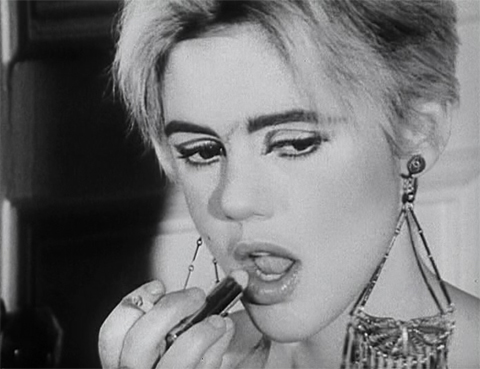

Andy Warhol’s many silent Screen Tests provide examples of his predilection for the close-up, as do some of his other films, such as Blow Job (1964), Henry Geldzahler (1964), and Outer and Inner Space (1965). Made during his collaborative period with Chuck Wein, Face (1965) has recently been preserved, along with The Velvet Underground in Boston (1967), in honor of the late Callie Angell. It resurfaced at MoMA yesterday and will be screened again today after not being shown for forty years. Because Face hasn’t been in circulation since Warhol withdrew his films around 1970 and was screened infrequently at the time it was made, it received little attention from early Warhol film scholars, such as Stephen Koch, Jonas Mekas, or Peter Gidal. As a result, the film comes as a major revelation and provides a crucial link in the phase of Warhol’s filmmaking involving Edie Sedgwick.
In Face, Warhol focuses exclusively on a close-up of Edie’s face for the entire 66-minute film, thereby demonstrating that his most famous superstar had the ability to command an audience’s attention while merely playing music, applying makeup and accessories, smoking marijuana, talking on the phone with a friend, and conversing with Chuck Wein, who, as usual, remains an elusive figure offscreen. According to Tony Scherman and David Dalton in Pop: The Genius of Andy Warhol, “Edie’s dalliances with lipstick and makeup were similarly epic. Chronically late, she could easily spend three hours doing her face to the exasperation of anyone who happened to be waiting for her to show up. Her belated arrivals at parties and openings, hours after she was expected, created a sense of drama and seemed the sign of a true diva.”
Warhol had the idea of filming Edie’s life over the course of an entire day. He claimed: “I only wanted to find great people and let them be themselves and talk about what they usually talked about and I’d film them for a certain length of time and that would be the movie.” Like other Chuck Wein films featuring Edie, Face could be understood in relation to this concept, but it fails to account for the formal choices Warhol makes: the decision to shoot back and white film stock, his use of a fixed camera, the close framing, the careful attention to lighting, and the film’s structure.
If this were simply a recording of a segment of Edie’s life (in this case, shot in a continuous close-up), as Warhol would have us believe, it wouldn’t be nearly as interesting. The concept behind the film, as was true of all of the Chuck Wein films, was to set up Edie for something unexpected to happen. What actually occurs is that Edie becomes so high during the course of the film, that when she makes a statement and expresses a viewpoint that she assumes Chuck shares, he suddenly plays a “mind game” on her, which alters the dynamics of the film. By having the camera close to Edie’s face, we’re able to view her stunned reaction.
Face might prove to be the best vehicle for displaying what made Edie the greatest Warhol superstar, namely her incredible presence on camera. Her radiant facial features have tremendous visual impact, which is the quality that attracted Warhol to her. As Bibbe Hansen, who appeared in several Warhol films, puts it in Edie: Girl on Fire: “Looking back at me looking at it then – we’re getting very Proustian here – she had the most amazing and wonderful quality to live in the film frame. To live there, to breathe, to inhabit it.” While Edie manages to inhabit an extremely tight frame, it is the final three minutes of Face that prove most riveting. Warhol claimed that all his films were “artificial” because he didn’t know “where the artificial stops and the real starts.” The major interest in Face is in how the film explores this boundary.
Note: For a detailed analysis of Face and other Warhol films, please see my book The Black Hole of the Camera: The Films of Andy Warhol (University of California Press, 2012).
###
Image © 2010 The Andy Warhol Museum, Pittsburgh, PA, a museum of Carnegie Institute. All rights reserved. Film still courtesy of The Andy Warhol Museum.